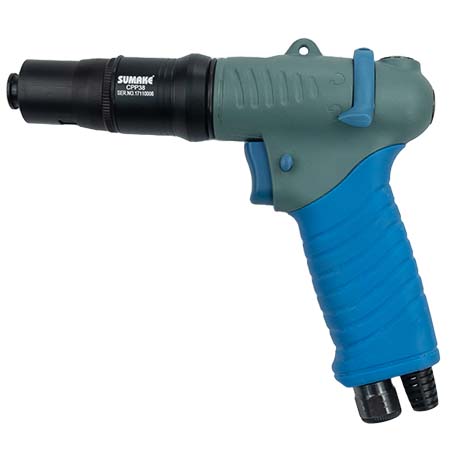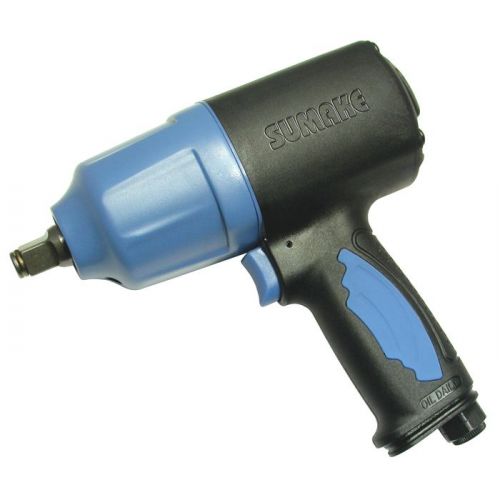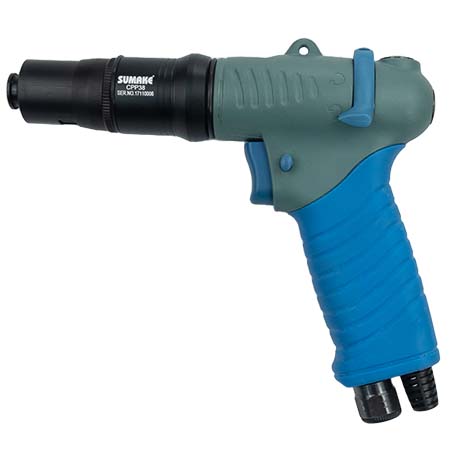Compressed air tools are one of the most important branches of technology that make work much easier and speed up production processes. They are used in many industries such as automotive, aerospace, metallurgy and many others. Compressed air tools are, first and foremost, devices that use compressed air as a source of energy.
Pneumatic tool drive systems are made up of several elements, such as: compressor, tank, filter, pressure reducer, pressure regulator, hoses and tool. The compressor is the heart of the system; it sucks air from the room and compresses it to the appropriate pressure. The air is then directed to a tank where it is stored and delivered to the tool when in use.
To ensure the reliability and efficiency of pneumatic tools, the air is filtered and regulated using a filter, a pressure reducer and a pressure regulator. This way, the air is cleaned of contaminants and stabilized at the correct pressure to ensure optimal tool operation.
Pneumatic tools are very versatile and offer many advantages over mechanical tools. They are smaller, lighter, more durable and more comfortable to wear. Furthermore, thanks to the use of compressed air, they are more precise and efficient, as well as safer for the user.
What are pneumatic tools and how do they work?
Compressed air tools are devices that use compressed air for a variety of tasks. They are widely used in many industries such as automotive, construction and manufacturing. Pneumatic tools use compressed air to transfer mechanical energy to the work tool.
The air that supplies the pneumatic devices is compressed by a compressor and then sent to the tool through a special hose. The air in the tool is then released, causing the tool to move. It could be, for example, the blow of a hammer, the movement of a piston or the rotation of a tool. Many pneumatic tools come with airflow regulators that allow you to control the force and speed of the tool.

Pneumatic tools have great resistance, speed and precision, which makes them very useful for many applications. Furthermore, they are safe and easy to use and are very attractive to many companies due to their low operating costs and low service costs.
In summary, pneumatic tools are modern and efficient devices used in many industries. Their reliability, ease of use and low cost make them increasingly popular and an important tool in many areas.
History of the development of pneumatic tools
Pneumatic tools are one of the most important tools used in many industries such as automotive, construction, industrial manufacturing and many others. From the first inventions to today's technologies, pneumatic tools have evolved and improved to respond to the increasingly demanding challenges and needs of the industry.
The first pneumatic tools were invented in the 19th century, when scientists began exploring the use of air as an energy source. At that time, air was used to drive machines such as hammers, drills and grinders. As pneumatic technology has advanced, pneumatic tools have become more advanced and efficient, allowing work to be completed more efficiently and quickly.
In recent decades, pneumatic tools have been significantly modernized, making them even more adaptable to the needs of different industries. Today, pneumatic tools are used in a variety of applications, such as assembling and disassembling automotive parts, metal and wood machining, and many other industrial and construction applications.
Overall, the history of compressed air tool development is full of developments and improvements that make them the most important tools in many industries today.
How pneumatic tools work
Compressed air tools work with compressed air. Its operation is based on the conversion of air energy into mechanical energy, which is used to carry out work.
The process begins with compressing air in a compressor. There, the air is compressed and filtered to remove contaminants and moisture and then transported to the pneumatic tool.
With pneumatic tools, air is introduced into a cylinder and compressed there. Compressed air is used to move a piston that is connected to a shaft and allows work.
Pneumatic tools are used for many different tasks such as drilling, grinding, cutting, fastening, etc. Its advantage is high resistance and speed, in addition to eliminating the use of cables and electrical lines.
In short, pneumatic tools work by compressing the air used to perform the work. They are easy to use and widely used across industries due to their universality.
Types of pneumatic tools
Pneumatic tools are a broad category of devices that work on the principle of air compression. There are many different types of pneumatic tools used in different applications.
Popular types of air tools include air screwdrivers, which are often used to assemble and disassemble components. They are much faster and more efficient than traditional hand tools, reducing the time needed to carry out the work.
Pneumatic hammers are another type of tool widely used in industry and construction. They are equipped with a percussion mechanism that allows squatting and hammering work to be carried out quickly and efficiently.

Pneumatic sanders are ideal for sanding metal, wood and other surfaces. Due to their efficiency and precision, they are highly valued in industry and commerce.
Pneumatic cutting machines are tools commonly used to cut metals, plastics and other materials. They are very efficient and allow you to make precise cuts in a short time.
Overall, pneumatic tools are an important tool for many industries because they offer speed, precision, and durability that cannot be achieved with traditional hand tools.
Advantages of pneumatic tools: power, reliability and speed
Due to their advantages such as performance, reliability and speed, pneumatic tools are a unique solution for many applications. Power is one of the most important factors affecting the performance of pneumatic tools. They are capable of performing many heavy-duty tasks, such as drilling holes in hard metal or fixing and removing screws.
Reliability is another important factor influencing the popularity of pneumatic tools. They are made from durable materials and are less prone to breakage than power tools. Pneumatic tools are also less prone to damage from overheating, a common problem with power tools.
Speed is the last important factor that influences the popularity of pneumatic tools. They are able to complete tasks faster than power tools, allowing you to complete your work faster and more efficiently. Pneumatic tools are particularly useful for large projects where time is of the essence.
In summary, pneumatic tools offer many advantages such as performance, reliability and speed. They are an excellent solution for many applications, both professional and amateur.
Disadvantages of pneumatic tools
Pneumatic tools are very popular in many industries, but their use has some disadvantages. Although these disadvantages do not always affect the efficiency and quality of work, they must be taken into account when choosing the appropriate tool.
One of the main disadvantages of pneumatic tools is their higher cost compared to electric or mechanical tools. Many pneumatic tools also require specialized equipment, such as a compressor and accessories, to function properly. Therefore, the costs associated with using pneumatic tools can be higher than other types of tools.
Another disadvantage of pneumatic tools is that air must be available for the tool to work. In many places, such as construction sites or workshops, there is no air source, which makes it impossible to use compressed air tools. In these situations, other tools need to be used, which can cause additional difficulties and delays.
In conclusion, although pneumatic tools are very useful and effective, there are some disadvantages to their use, such as: B. higher costs and air availability requirements. Therefore, it is important to carefully consider your needs and choose the tool that best suits your needs and working conditions.
Summary: Pneumatic tools and how they work
Compressed air tools are among the most important tools in industry and workshops. Their operation is based on the supply of air under pressure, which allows them to achieve high performance and precision. Pneumatic tools include: screwdrivers, hammers, grinders and cutters used for various tasks such as drilling, fastening and cutting.
Pneumatic tools offer many advantages such as performance, reliability and speed. However, its disadvantage is the higher cost compared to traditional tools, as well as the need to have an air source available.
In short, pneumatic tools are very useful tools that offer many advantages and allow you to perform different tasks with great precision and power. Although its price may be higher than traditional tools, its performance and reliability make it worth the investment.

























































